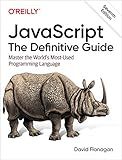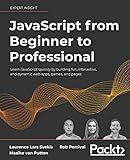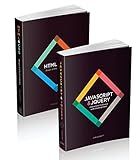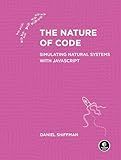Best JavaScript Override Guides to Buy in December 2025

JavaScript: The Definitive Guide: Master the World's Most-Used Programming Language



JavaScript from Beginner to Professional: Learn JavaScript quickly by building fun, interactive, and dynamic web apps, games, and pages



JavaScript: The Comprehensive Guide to Learning Professional JavaScript Programming (Rheinwerk Computing)



Web Design with HTML, CSS, JavaScript and jQuery Set
- TWO-VOLUME SET COMBINES ESSENTIAL WEB DESIGN TECHNOLOGIES.
- HIGHLY VISUAL FORMAT ENHANCES LEARNING FOR BEGINNERS.
- ACCESSIBLE LANGUAGE IDEAL FOR ASPIRING FRONT-END DEVELOPERS.



JavaScript and jQuery: Interactive Front-End Web Development
- MASTER JAVASCRIPT AND JQUERY WITH CLEAR, ENGAGING LESSONS.
- LEARN CORE PROGRAMMING CONCEPTS THROUGH INSPIRING EXAMPLES.
- VISUALIZE LEARNING WITH EASY-TO-FOLLOW DIAGRAMS AND DESCRIPTIONS.



JavaScript Programming for Beginners: Learn to Code with the Web’s Most Popular Language Through Hands-On Projects, Real-World Skills, and a Step-by-Step Beginner’s Guide



The Nature of Code: Simulating Natural Systems with JavaScript



JavaScript QuickStart Guide: The Simplified Beginner's Guide to Building Interactive Websites and Creating Dynamic Functionality Using Hands-On Projects (Coding & Programming - QuickStart Guides)



HTML, CSS, & JavaScript All-in-One For Dummies



JavaScript Crash Course: A Hands-On, Project-Based Introduction to Programming


To override a class in JavaScript, you can make use of inheritance and prototypes. Here's how you can do it:
- Define the original class: Start by creating the original class using the class keyword or a constructor function.
- Create the overriding class: Declare a new class that will override the original class or create a constructor function that will serve as the overridden class.
- Inherit from the original class: For class-based inheritance, use the extends keyword to inherit from the original class. For prototype-based inheritance, assign the prototype of the overriding class to an instance of the original class.
- Modify or add new functionality: Within the overriding class or its prototype, implement the modified or new functionality that should replace or extend the original class's behavior. Make sure to provide the necessary method or property definitions.
- Make use of super: If you need to access the original class's implementation or properties within the overriding class, you can use the super keyword to call the original class's method or access its properties.
- Instantiate and use the overriding class: Create an instance of the overriding class to utilize its modified or extended functionality. You can now use this instance instead of the original class.
Remember, class overriding in JavaScript uses either inheritance or prototype chain manipulation to modify the behavior of an existing class.
Are there any specific design patterns related to class overriding in JavaScript?
In JavaScript, the concept of overriding class methods or properties is achieved through prototype chaining and does not have specific design patterns associated with it. However, there are some common patterns that are used in JavaScript to modify or extend class behavior:
- Prototype Pattern: This pattern involves creating a prototype object that serves as a blueprint for creating other objects. By modifying the prototype, you can share properties and methods among different instances of a class.
- Mixin Pattern: Mixins allow you to extend the functionality of existing classes by copying or merging properties and methods from one object to another. This pattern is commonly used to achieve multiple inheritance-like behavior in JavaScript.
- Decorator Pattern: The decorator pattern is used to augment the functionality of a class dynamically. It involves wrapping the original class with another class that provides additional or modified behavior, usually by delegating calls to the original class.
- Factory Pattern: The factory pattern is used for creating instances of classes by providing a common interface. Through a factory, you can create objects with different prototypes or modify the behavior of existing classes.
It's important to note that JavaScript does not have a strict notion of class inheritance like some other programming languages. Instead, it uses prototype-based inheritance, which allows for more flexible and dynamic object-oriented programming.
How do you inherit a class before overriding it in JavaScript?
In JavaScript, you can inherit a class by using the extends keyword and the super() method. To override a method in the subclass, you simply redeclare the method with the same name and modify its behavior. Here's an example:
class Parent { sayHello() { console.log("Hello from parent class"); } }
class Child extends Parent { sayHello() { super.sayHello(); // calling the parent class method console.log("Hello from child class"); } }
const obj = new Child(); obj.sayHello();
In the above example, the Child class extends the Parent class using the extends keyword. The sayHello() method is overridden in the Child class, but before modifying its behavior, the super.sayHello() is called to invoke the same method from the parent class.
What are some common scenarios where class overriding is useful?
Class overriding is useful in several scenarios, including:
- Inheritance: When working with inheritance, you can override methods in the base class to provide specific implementations in derived classes. This allows you to customize the behavior of the derived class while sharing common functionality with the base class.
- Polymorphism: By overriding methods, you can implement polymorphic behavior. This means that different objects of the same superclass can behave differently based on their specific implementation of an overridden method.
- Extensibility: Overriding allows you to extend the functionality of a class without modifying the existing code. You can add new methods or modify the behavior of existing methods by providing your own implementations in a derived class.
- Frameworks and Libraries: When working with frameworks or libraries, you may need to override certain methods provided by the framework to adapt them to your specific needs. This allows you to customize the behavior and functionality provided by the framework.
- Adapting Interfaces: In some cases, you may have a class that implements an interface but needs to provide a slightly different behavior than the default implementation specified in the interface. By overriding the methods of the interface, you can adapt the behavior and make it more suitable for your specific use case.
- Testing: Overriding methods can also be useful in testing scenarios. You can create fake or stub methods in test classes that override certain behavior of the original class to isolate and test specific functionality without affecting the original implementation.
Overall, class overriding is useful in situations where you need to customize or extend the behavior of existing classes, enable polymorphic behavior, or adapt interfaces to suit your requirements.
